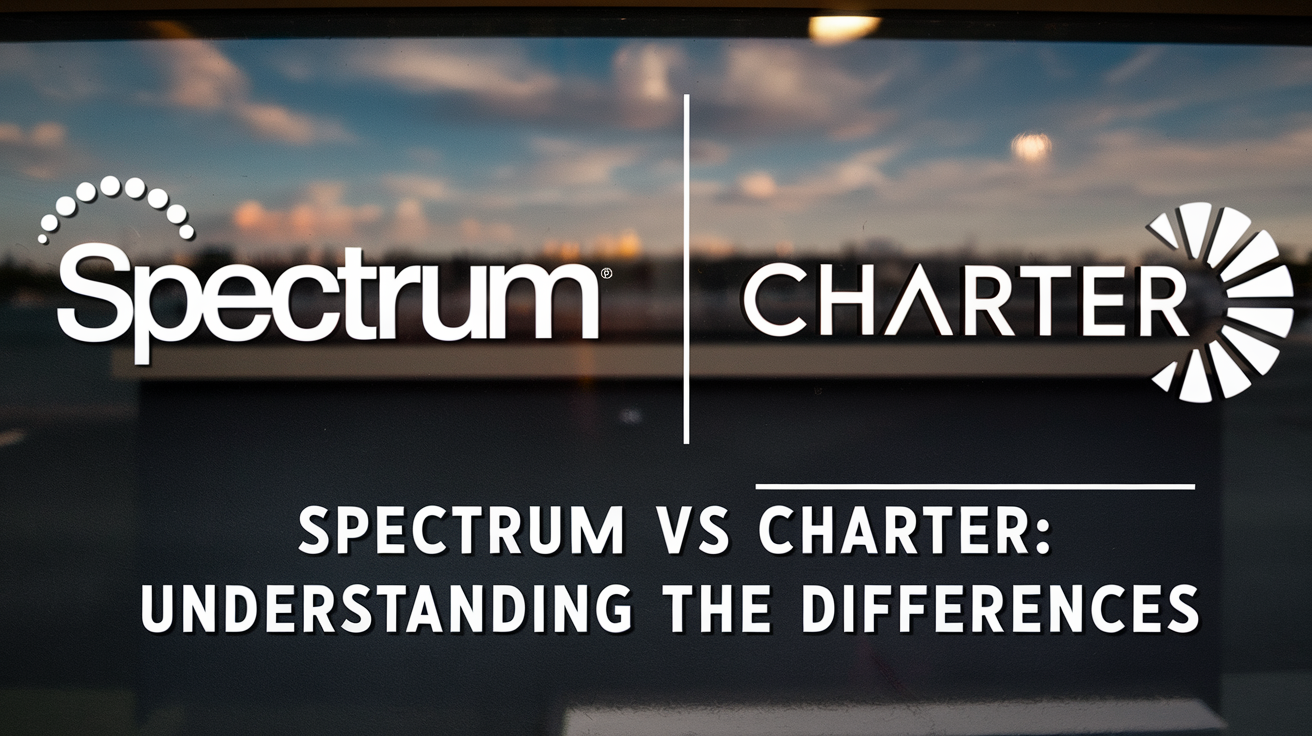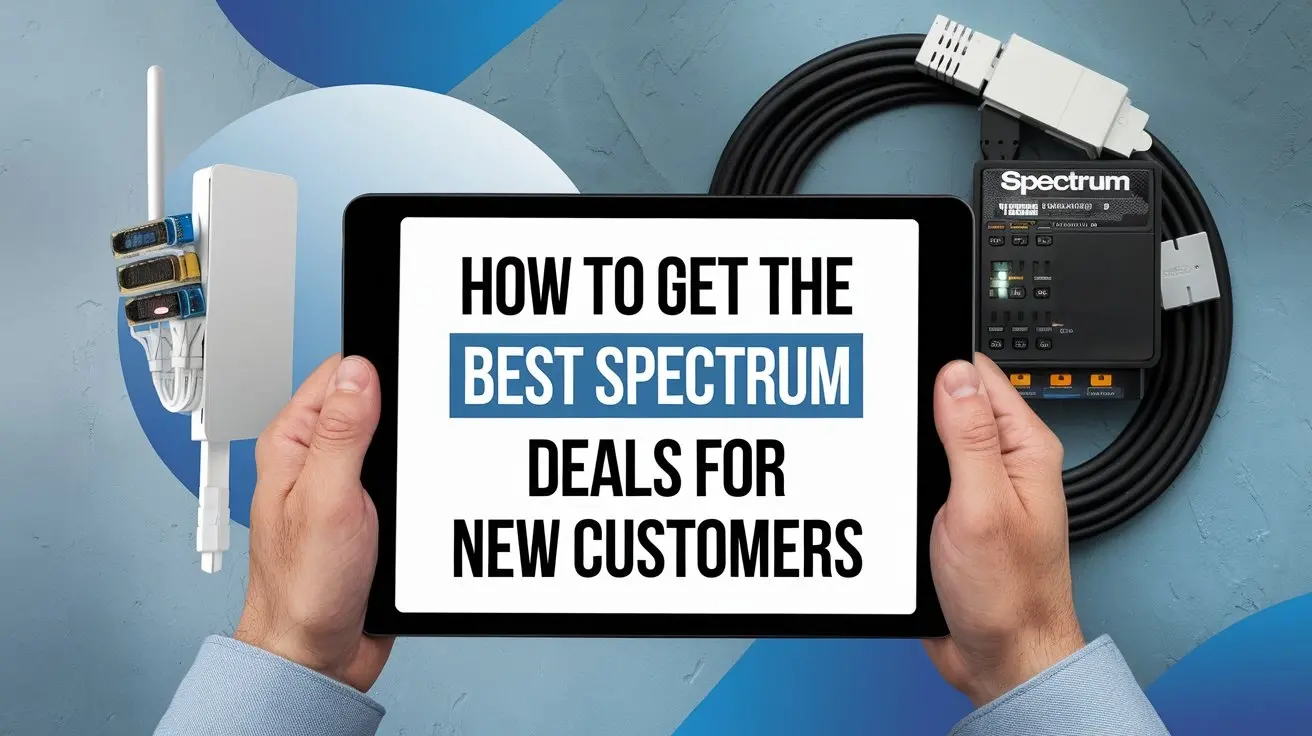Spectrum vs Charter: Understanding the Differences

Choosing between Spectrum and Charter internet requires understanding their service areas, speeds, pricing, and customer support. This comprehensive guide details their offerings in 2025, comparing key features to help you make an informed decision based on your specific needs and location.
Spectrum vs Charter: Understanding the Differences in 2025
In the ever-evolving landscape of internet service providers (ISPs), consumers often face a bewildering array of choices. Two prominent names that frequently appear in discussions about broadband connectivity are Spectrum and Charter. For many, the distinction between these two can be a source of confusion, leading to questions about their service offerings, pricing, and overall value. This article aims to demystify the relationship between Spectrum and Charter, providing a comprehensive comparison tailored for 2025. We will delve into their service areas, internet speeds, bundle packages, customer service experiences, and the underlying corporate structure that connects them. By the end of this guide, you will have a clear understanding of what sets Spectrum and Charter apart, enabling you to make an informed decision for your home or business internet needs.
The internet service market is highly competitive, with providers constantly vying for customer loyalty through improved technology, attractive pricing, and enhanced service offerings. Understanding the nuances between providers like Spectrum and Charter is crucial for securing a reliable and cost-effective internet connection. This analysis will equip you with the knowledge to navigate these options effectively, considering factors such as download and upload speeds, data caps (or lack thereof), contract requirements, and the quality of customer support. As we move through 2025, technological advancements continue to shape the broadband experience, making it imperative to stay updated on the latest developments and how they impact major players in the industry.
A Tale of Two Brands: The Charter Communications Connection
The most significant point of clarification regarding Spectrum and Charter is their fundamental relationship: they are, in essence, the same company. Charter Communications is the parent company that operates under both the Charter and Spectrum brand names. Charter Communications is one of the largest broadband communications companies in the United States, providing its services to millions of households and businesses. Historically, Charter acquired Time Warner Cable and Bright House Networks, and over time, it rebranded most of its acquired services under the unified Spectrum banner. This rebranding initiative aimed to standardize the customer experience, service offerings, and marketing across its vast service footprint.
Therefore, when you are looking at Spectrum internet or Charter internet, you are typically looking at services provided by the same corporate entity. The difference in naming often stems from geographical location or legacy branding from previous acquisitions. In many regions, the Spectrum brand has become the primary customer-facing identity for Charter's internet, TV, and phone services. However, in some areas, particularly those with a strong historical presence of Time Warner Cable or Bright House Networks before the acquisition, the Charter name might still be in use or appear on bills and service agreements. This can lead to the perception that they are separate entities, when in reality, they are facets of the same large corporation.
The Spectrum Rebranding Strategy
Charter's decision to consolidate under the Spectrum brand was a strategic move to simplify its operations and create a consistent brand identity. This rebranding involved updating signage, marketing materials, customer service scripts, and product offerings. The goal was to streamline the customer journey, making it easier for subscribers to understand what services are available and how to access them, regardless of their location. This unification also allowed Charter to leverage its infrastructure more efficiently and offer more competitive packages across its entire service territory. As of 2025, the Spectrum brand is dominant, but the Charter name may persist in certain legacy markets or in corporate communications.
Implications for Consumers
For the average consumer, the key takeaway is that the core service, technology, and network infrastructure behind Spectrum and Charter are largely identical. This means that the internet speeds, reliability, and general service quality you experience will be determined by Charter's network in your specific area, rather than by a fundamental difference between the "Spectrum" and "Charter" brands themselves. The primary differences you might encounter will be in the specific pricing, package names, promotional offers, and local customer service representatives, which can vary slightly by region due to market conditions and historical operational structures.
Key Differentiating Factors in 2025
While Spectrum and Charter are part of the same company, subtle differences can emerge due to regional variations, specific marketing campaigns, and the legacy infrastructure of acquired companies. Understanding these nuances is vital for consumers seeking the best possible service. These factors can include the exact naming of internet plans, the specific speeds offered at different price points, the availability of promotional discounts, and the local customer service experience.
Regional Variations in Service Packages
Charter's network is geographically segmented. While the Spectrum brand aims for uniformity, the specific plans and pricing available can differ significantly from one state or even one city to another. This is often a legacy of the networks Charter acquired. For instance, a customer in a former Time Warner Cable area might see slightly different plan names or introductory pricing compared to a customer in a region that was always primarily Charter territory. These regional differences are a primary reason why a direct comparison between "Spectrum" and "Charter" can appear complex, even though the underlying service is from the same provider.
Promotional Offers and Contract Terms
Promotional pricing is a common tactic used by ISPs to attract new customers. As of 2025, both Spectrum and Charter (operating as Spectrum) utilize these strategies. However, the duration of these introductory offers, the specific discounts applied, and the terms of any required contracts can vary by region. Some areas might offer more aggressive introductory pricing to compete with local rivals, while others might have standard pricing structures. It's essential to carefully read the fine print for any promotional offer to understand the price after the introductory period ends and to be aware of any early termination fees.
Equipment and Installation Fees
While Charter has made efforts to standardize its equipment policies, there can still be slight variations in modem rental fees or professional installation charges depending on the region and the specific package chosen. Most plans include a modem, but customers may have the option to purchase their own compatible modem to avoid monthly rental fees. Installation fees can also differ, with some areas offering free professional installation as a promotional incentive, while others may charge a standard fee. Understanding these potential ancillary costs is crucial for accurately comparing the total cost of service.
Bundling Synergies
Both Spectrum and Charter heavily promote bundled services, combining internet, TV, and phone. The specific bundles available, the channels included in TV packages, and the features of phone services can vary regionally. Sometimes, a particular bundle might be marketed more aggressively in one area than another, leading to perceived differences. These bundles often offer cost savings compared to subscribing to each service individually, making them an attractive option for many households.
Navigating Service Availability: Where Each Provider Shines
One of the most critical factors in choosing an internet provider is availability. Charter Communications, operating as Spectrum, has a vast network that spans across 41 states in the United States. However, its presence is not uniform. Spectrum's footprint is particularly strong in the Northeast, Midwest, and parts of the South. Its expansion has largely been through acquisitions, integrating the infrastructure of companies like Time Warner Cable and Bright House Networks.
As of 2025, Charter is one of the top three largest cable operators in the U.S. by number of subscribers. Its service areas are typically characterized by densely populated urban and suburban regions, as well as some rural communities where it has established a significant presence. The company's strategy involves leveraging its extensive cable network to deliver high-speed internet, television, and voice services.
Geographic Footprint and Market Penetration
Spectrum's service availability is dictated by the physical cable lines laid by Charter and its predecessors. This means that if you live in a major metropolitan area or a well-established suburb in one of the 41 states where Charter operates, you are highly likely to have access to Spectrum services. The company has invested heavily in upgrading its network to deliver faster speeds and more reliable connections. However, in some more remote or less densely populated rural areas, while Charter might operate, the available speeds or package options might be more limited compared to urban centers.
Comparing Availability with Competitors
Compared to other major ISPs like Comcast (Xfinity) or AT&T, Spectrum's coverage is extensive but has its own specific geographic concentrations. While AT&T offers a mix of fiber and DSL, and Comcast focuses on cable, Spectrum primarily relies on its extensive coaxial cable network, with increasing deployments of its own fiber-to-the-home (FTTH) technology in select areas. This means that in areas where Spectrum is available, it often competes directly with other cable providers or with DSL services. In regions where Charter has acquired smaller cable companies, the brand name might still be "Charter," but the service is managed under the Spectrum umbrella. The key is to check availability at your specific address, as even within the same city, service availability can vary.
How to Check Availability
The most accurate way to determine if Spectrum or Charter services are available at your location is to visit the official Spectrum website and use their address checker tool. This tool will provide a definitive list of available internet, TV, and phone plans for your specific address. You can also call their customer service line to inquire about availability. Remember, even if a neighbor has service, it's always best to verify for your exact address, as infrastructure can vary block by block.
Speed and Performance: What to Expect in 2025
When it comes to internet speed and performance, Spectrum and Charter, being part of the same company, generally offer comparable services. As of 2025, Charter has been actively upgrading its network to provide faster download speeds and improve upload speeds, moving towards a more symmetrical experience in some areas with its DOCSIS 3.1 and emerging DOCSIS 4.0 technologies. The speeds you can expect will depend on the specific plan you choose and the infrastructure in your local area.
Download and Upload Speeds
Spectrum's most commonly advertised entry-level internet plan offers download speeds of around 300 Mbps. This is generally sufficient for basic internet use, including web browsing, email, and streaming standard-definition content on a few devices. However, for households with multiple users, heavy streaming of 4K content, online gaming, or frequent large file downloads, higher speed tiers are recommended. Spectrum offers plans that can reach download speeds of up to 1 Gbps (1000 Mbps) in many areas. These higher-tier plans are crucial for a smooth, buffer-free experience with demanding online activities.
A significant point of comparison for many users is upload speed. Traditionally, cable internet providers have offered much lower upload speeds than download speeds. However, Charter has been working to improve this. While exact figures vary, many Spectrum plans offer upload speeds that are a fraction of their download speeds (e.g., 300 Mbps download / 10 Mbps upload). In areas where Charter has deployed DOCSIS 3.1 or is testing DOCSIS 4.0, upload speeds are seeing substantial improvements, sometimes reaching 50-100 Mbps or more, which is beneficial for video conferencing, uploading large files, and live streaming.
Network Technology and Reliability
Spectrum primarily utilizes a hybrid fiber-coaxial (HFC) cable network. This technology is known for delivering high download speeds and generally good reliability, especially in areas where the infrastructure is well-maintained and recently upgraded. Fiber-to-the-home (FTTH) is also being deployed in select markets, offering superior performance and symmetrical speeds. The reliability of Spectrum's service can vary by location. Factors such as network congestion, the age of the local infrastructure, and the frequency of maintenance or upgrades can all impact performance. Charter has invested billions in network upgrades, which is reflected in the generally positive reliability reports for its Spectrum services.
Data Caps and Throttling
A significant advantage of Spectrum (and by extension, Charter) is its policy on data caps. As of 2025, Spectrum does not impose data caps on its internet plans. This means you can use as much internet data as you need without worrying about exceeding a limit and incurring overage charges or having your speeds throttled. This is a major selling point for heavy internet users, streamers, and gamers. In contrast, some other ISPs, particularly those offering DSL or fixed wireless, may have strict data caps that can limit your online activity.
Performance for Specific Activities
For basic activities like email and web browsing, even Spectrum's lowest-tier plans are more than adequate. For streaming HD content, plans with 100-300 Mbps download speeds are generally sufficient for one or two devices. To stream 4K content on multiple devices simultaneously, enjoy lag-free online gaming, or conduct frequent video conferences with high-quality video, plans offering 500 Mbps or 1 Gbps download speeds are recommended. The improved upload speeds in newer deployments also enhance the experience for video calls and content creation.
Pricing Structures and Hidden Costs
Understanding the pricing of internet services is often where consumers encounter the most confusion. For Spectrum and Charter, the pricing structures are generally similar due to their unified corporate identity. However, regional variations, promotional offers, and additional fees can create apparent differences. As of 2025, Charter continues to employ a strategy that often involves attractive introductory pricing followed by a price increase after a promotional period. It's crucial to look beyond the advertised monthly rate.
Advertised vs. Actual Costs
Spectrum's advertised prices typically reflect an introductory rate that is valid for a set period, usually 12 or 24 months. After this period, the price for the internet plan will increase to the standard rate. These standard rates can be significantly higher than the promotional prices. For example, a 300 Mbps plan advertised at $49.99/month might jump to $79.99/month after the promotional period expires. It is essential to inquire about the standard rate when signing up and to factor this into your long-term budget. The "Charter" branded services will follow a similar pricing model.
Equipment Rental Fees
Most Spectrum internet plans require the use of their provided modem and Wi-Fi router (often a combined unit). There is a monthly rental fee associated with this equipment, which can add $10-$20 per month to your bill. While this is standard for many cable ISPs, it's a cost that should be factored into the overall monthly expense. Customers often have the option to purchase their own compatible modem and router to eliminate this recurring fee, though it requires ensuring compatibility and proper setup. Check the Spectrum website or customer service for the latest equipment rental fees and compatible device lists.
Installation and Activation Fees
When you first sign up for Spectrum service, you will typically encounter an installation fee and an activation fee. These fees can range from $50 to $100 or more, depending on the type of installation (self-install vs. professional install) and regional promotions. Charter often offers free professional installation as a promotional incentive to new customers, especially when signing up for bundled packages. However, if you opt for a self-installation, there might be a reduced activation fee. It's wise to ask about any current promotions that waive these upfront costs.
Contract Terms and Early Termination Fees
A significant advantage of Spectrum's internet service is that it typically does not require long-term contracts. Most plans are month-to-month, offering flexibility for customers who may move or wish to switch providers. This means there are generally no early termination fees (ETFs) if you decide to cancel your service. This contrasts with some competitors who may lock customers into one- or two-year contracts. This contract-free approach is a key selling point for Spectrum and is consistent across its operations, whether branded as Spectrum or Charter.
Regional Pricing Differences
Despite the unified brand, pricing can still vary slightly by region. This is often due to local market competition and the specific cost structures of maintaining the network in different areas. A plan that costs $70/month in one city might be $75/month in another for the same speed tier. These differences are usually minor but can add up. Always verify the exact pricing for your specific address on the Spectrum website or by speaking with a sales representative.
Bundling Options: Internet, TV, and Phone Packages
Charter Communications, operating under the Spectrum brand, offers comprehensive bundled packages that combine internet, television, and phone services. Bundling is a common strategy employed by ISPs to increase customer loyalty and provide a more convenient, often cost-effective, solution for households. As of 2025, Spectrum's bundling options are designed to cater to a wide range of consumer needs, from basic connectivity to premium entertainment packages.
Internet + TV Bundles
Spectrum offers various internet and TV bundles, typically starting with a mid-tier internet speed (e.g., 300 Mbps) paired with a basic cable TV package. These packages can be scaled up to include faster internet speeds and a more extensive selection of channels, including premium networks like HBO, Showtime, and sports channels. The benefits of bundling TV and internet include a single bill, potential cost savings compared to subscribing to each service separately, and often a more streamlined customer service experience. The specific channel lineups and internet speeds will vary based on the chosen bundle and region.
Triple Play Packages (Internet + TV + Phone)
For customers seeking a complete home communication solution, Spectrum's Triple Play packages are available. These bundles include high-speed internet, a comprehensive TV package, and unlimited local and long-distance phone service. This option is particularly attractive for households that still rely on traditional landline phones or want to consolidate their essential home services. The pricing for Triple Play bundles is often more aggressive than purchasing the services individually, making it a popular choice for value-conscious consumers. As with other bundles, the exact offerings can differ by location.
Benefits of Bundling
The primary benefit of bundling Spectrum services is cost savings. By packaging multiple services together, Charter can offer discounted rates that are typically lower than subscribing to each service independently. Another advantage is convenience: a single monthly bill simplifies household budgeting and management. Furthermore, bundling can sometimes unlock access to better promotional offers or faster installation times. For customers who need all three services, bundling with Spectrum is often a very competitive option.
Considerations Before Bundling
While bundling offers advantages, it's essential to evaluate your actual needs. If you rarely watch traditional cable TV or already use a mobile phone as your primary communication device, a Triple Play bundle might include services you don't fully utilize, potentially making it less cost-effective than a standalone internet plan or a Double Play (Internet + TV) bundle. Always compare the bundled price against the cost of individual services from Spectrum or other providers to ensure you are getting the best value. Also, remember that promotional pricing on bundles typically expires, and the price will increase to the standard rate.
Customer Service and Reliability: A Crucial Comparison
Customer service and network reliability are paramount when choosing an internet provider. While Spectrum and Charter are the same company, the customer experience can vary based on location, the specific issue, and the representative you interact with. Charter has made significant investments in improving its customer service and network infrastructure, but like any large telecommunications company, it faces challenges and receives mixed reviews.
Customer Service Channels
Spectrum offers multiple channels for customer support. These include phone support, online chat, and in-person service centers. For technical issues, billing inquiries, or service changes, customers can contact Spectrum's customer service representatives. The quality of support can vary; some customers report positive and efficient resolutions, while others experience longer wait times or difficulty resolving complex issues. The company also provides a comprehensive online portal with FAQs, troubleshooting guides, and account management tools.
Network Reliability and Uptime
Spectrum's network reliability is generally considered good, especially in areas where the infrastructure has been recently upgraded. As a cable provider, its network is designed for high bandwidth and can handle significant data traffic. However, like all wired internet services, it can be susceptible to outages caused by local infrastructure issues, power outages, or severe weather. Charter has been investing in network hardening and expansion, including fiber optic upgrades, to improve resilience and uptime. Independent reports and customer feedback suggest that while occasional outages can occur, Spectrum generally provides a stable internet connection for most users.
Technician Visits and Installation Quality
When a technician visit is required for installation or repair, the experience can vary. Spectrum technicians are employees of Charter, and their training and professionalism are key to a positive customer experience. Most installations are completed efficiently, but issues can arise, such as delays in appointment windows or incomplete repairs. Charter's ongoing training programs aim to improve the quality of service provided by its field technicians.
Online Resources and Self-Help
Spectrum provides a robust online platform for customers to manage their accounts, pay bills, and access troubleshooting resources. This includes detailed FAQs, video tutorials, and a service status checker. For many common issues, customers can find solutions through these online resources, potentially avoiding the need to contact customer service directly. The availability of self-help tools is a positive aspect of Spectrum's service offering.
User Reviews and Satisfaction Ratings for 2025
Customer satisfaction with internet providers is a critical metric for potential subscribers. While Spectrum and Charter are the same company, user reviews and satisfaction ratings often reflect regional experiences and the specific service tiers chosen. As of 2025, customer feedback for Spectrum is generally mixed, with common themes emerging regarding pricing, customer service, and internet speeds.
Common Praises
Many customers praise Spectrum for its lack of data caps, which is a significant advantage over some competitors. The availability of high-speed internet tiers, including gigabit speeds, is also frequently highlighted as a positive. Customers in areas with well-maintained infrastructure often report stable and reliable service. The contract-free nature of Spectrum's plans is another frequently cited benefit, offering flexibility and avoiding the commitment associated with long-term contracts.
Common Criticisms
The most common criticisms of Spectrum revolve around pricing. Many users find that the price increases significantly after the initial promotional period ends, leading to frustration. Customer service experiences can also be inconsistent, with some customers reporting long wait times or difficulties in resolving issues. While upload speeds have improved, some users still find them to be slower than desired, especially compared to fiber optic competitors. The cost of equipment rental is another recurring point of contention.
Comparison with Industry Averages
Industry satisfaction surveys, such as those conducted by J.D. Power and Consumer Reports, typically place Spectrum in the middle to upper-middle tier among major ISPs. It often scores better than some national providers but may lag behind smaller, regional fiber providers in terms of overall customer satisfaction. Its strengths lie in its widespread availability and high-speed offerings, while its weaknesses are often related to pricing transparency and customer service responsiveness. For 2025, these trends are expected to continue, with Charter working to address customer feedback through network improvements and service enhancements.
Impact of Local Infrastructure
It's important to note that customer satisfaction can be heavily influenced by the quality of the local infrastructure. In areas where Spectrum has invested in recent upgrades, customers tend to report higher satisfaction with speed and reliability. Conversely, in older service areas with less updated infrastructure, customers may experience more performance issues and express greater dissatisfaction. This regional variability is a key factor when interpreting user reviews.
Making the Right Choice: A Step-by-Step Decision Guide
Deciding between Spectrum and Charter might seem confusing, but remember they are the same company. The real decision lies in choosing the right plan and package for your specific needs and location. Here's a step-by-step guide to help you navigate the process in 2025:
Step 1: Determine Your Internet Needs
Consider how you use the internet. Are you a light user (email, browsing), a moderate user (streaming HD, social media), or a heavy user (4K streaming, online gaming, multiple devices, large file uploads/downloads)? This will help determine the download and upload speeds you require. For most households, 300 Mbps download is a good starting point, but heavy users may need 500 Mbps or 1 Gbps.
Step 2: Check Service Availability at Your Address
Visit the Spectrum website and use their address checker. This is the most crucial step, as it will show you precisely which plans, speeds, and bundles are available at your specific location. Do not rely on general availability maps.
Step 3: Compare Available Plans and Pricing
Once you know what's available, compare the different speed tiers. Pay close attention to the promotional price, the standard price after the promotion ends, and the contract terms (or lack thereof). Note any equipment rental fees, installation charges, and taxes.
Step 4: Evaluate Bundling Options
If you also need TV or phone services, compare the bundled packages. Calculate the total cost of the bundle and compare it to the cost of individual services from Spectrum or other providers. Ensure the TV channel lineup meets your needs if you opt for a TV bundle.
Step 5: Read the Fine Print and Ask Questions
Before signing up, carefully review all terms and conditions. Ask customer service representatives about any hidden fees, the duration of promotional pricing, and what happens when the promotion ends. Clarify installation procedures and appointment windows.
Step 6: Consider Your Budget and Priorities
Balance your desired speeds and services with your budget. If cost is the primary concern, look for the most affordable plan that meets your minimum needs. If performance and reliability are paramount, be prepared to invest in higher-tier plans, understanding the long-term costs.
Conclusion
In conclusion, the distinction between Spectrum and Charter internet services in 2025 is primarily one of branding rather than fundamental operational differences. Both are facets of Charter Communications, one of the largest broadband providers in the United States. This means that the core technology, network infrastructure, and general service quality are largely consistent across both names, dictated by Charter's network in your specific geographic area. The key to making an informed decision lies not in differentiating between Spectrum and Charter as separate entities, but in understanding the specific plans, pricing, and service offerings available at your address under the Spectrum brand.
When evaluating your options, prioritize checking service availability at your exact address on the Spectrum website. Spectrum generally offers competitive speeds, with plans ranging from 300 Mbps to 1 Gbps download, and a significant advantage of no data caps, making it ideal for heavy internet users. Be mindful of the pricing structure: advertised rates are typically promotional and will increase after an introductory period. Factor in potential equipment rental fees and installation costs to determine the true monthly expense. Bundling internet with TV and phone services can offer cost savings, but it's essential to ensure you need all the services included to maximize value.
Customer service experiences can be varied, as is common with large telecommunications companies. While Spectrum generally provides reliable service, it's wise to research local reviews for insights into network performance and support responsiveness in your area. The contract-free nature of Spectrum's plans offers considerable flexibility, a major plus for consumers who value the ability to switch providers without penalty. Ultimately, the best choice depends on your individual needs for speed, your budget, and the specific packages available to you. By following the steps outlined in this guide and focusing on the details of the plans offered in your region, you can confidently select the internet service that best suits your household.





